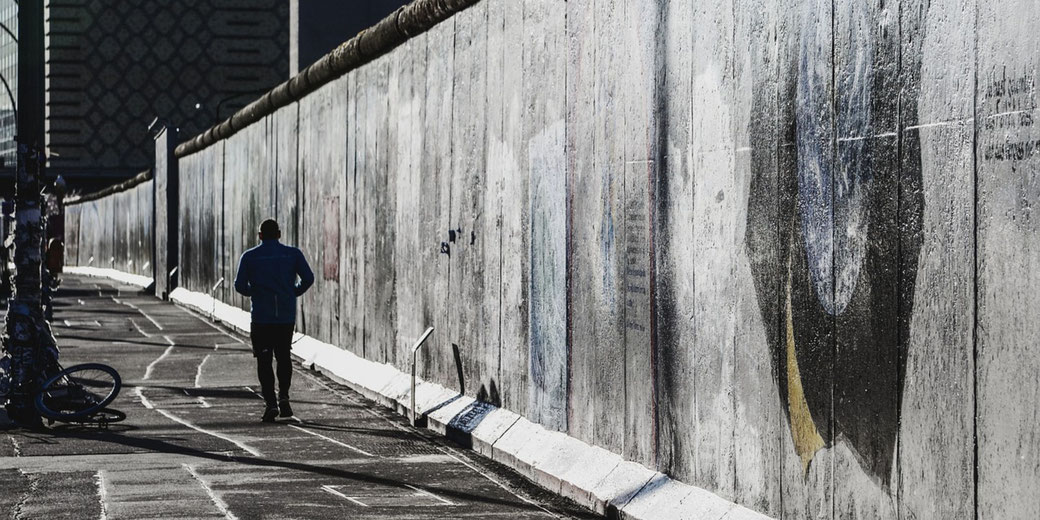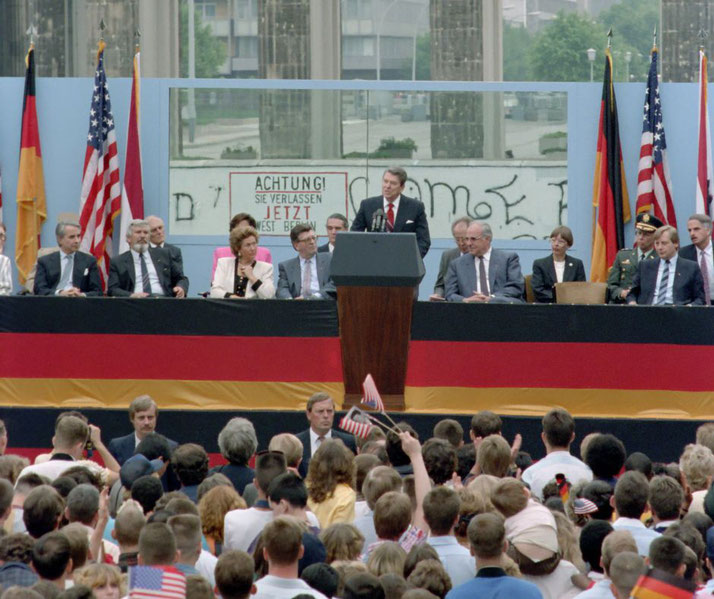The dramatic series of events that led to the fall of the Berlin Wall

Shortly after 11:00 p.m. on 9 November 1989, thousands of East Berliners poured through the Bornholmer Strasse border crossing without resistance.
Border guards stood aside, unsure of what orders to follow. Some attempted to stamp passports; others simply opened the gates.
For 28 years, the Berlin Wall had cut through the heart of the German capital, a physical barrier based on political ideas that divided families, showed strict government control, and led to more Cold War conflict.
Its collapse unfolded with remarkable speed, but it started because of political mistakes and growing public pressure at the same time as Soviet support ended.
Why was the Berlin Wall built?
In the wake of Germany’s defeat in the Second World War, the Allied powers divided both the country and its capital.
The Soviet Union controlled the eastern half, while the United States, Britain, and France administered the western sectors.
Berlin, located entirely within the Soviet zone of occupation, was also split among the four powers.
Tensions between the Western Allies and the Soviet Union intensified as the Cold War began.
By 1949, the western sectors had been combined into the Federal Republic of Germany (West Germany), and the Soviet-controlled area became the German Democratic Republic (East Germany).
Between 1949 and 1961, roughly 2.7 million people fled East Germany, most through the open border in Berlin.
This departure of many young professionals threatened the East German economy.
In response, the East German government, with Soviet support, began building a barrier on 13 August 1961.
The first barbed wire fences and concrete blocks soon changed into a strong wall, complete with guard towers, anti-vehicle trenches, and a 100-metre-wide "death strip" watched by armed guards.
Notably, on 15 June 1961, just under two months before construction began, East German leader Walter Ulbricht had publicly declared, "Niemand hat die Absicht, eine Mauer zu errichten" ("No one has the intention to build a wall"), at a time when high-level discussions with Moscow were already underway, though final Soviet approval came only shortly before the Wall's erection.
The Wall’s official purpose was to prevent "fascist elements" from entering the GDR.
In practice, it aimed to stop East Germans from fleeing to the West. It soon became the most visible symbol of Cold War division.
Over the following decades, it also came to represent the inability of the communist system to retain its own citizens without coercion.

What was life like in a divided Berlin?
On each side of the Wall, life took sharply different paths. West Berlin, surrounded by communist territory, received extensive financial support from the West and became an example of capitalist success.
It developed into a busy city with a strong cultural scene and high living standards; residents also enjoyed democratic freedoms.
Meanwhile, East Berlin operated under strict socialist rule. The ruling Socialist Unity Party (SED) maintained close surveillance on the population through the Stasi, one of the most harsh intelligence services in the world.
By the 1980s, the Stasi had grown to employ around 91,000 full-time agents and approximately 189,000 informants, which allowed the Stasi to monitor almost every part of daily life.
People lived under constant watch, with neighbours, colleagues, and even family members acting as informants.
In the East, travel to the West was banned without permission, and rule-breaking often led to jail or death.
More than 140 people were killed when they attempted to cross the Wall. Peter Fechter was a teenager shot and left to die in August 1962, with U.S. personnel among the onlookers who watched helplessly because of non-intervention orders.
Families were divided, and many lost contact for decades. Basic goods were available, but shortages were common, and political dissent was stopped.
At the same time, the state promised education and healthcare; it also provided employment for all citizens.
For some East Germans, this provided a degree of stability, but the lack of freedom and the inability to affect political decisions bred anger and doubt.
By the 1980s, the economic gap between East and West had widened noticeably, and unhappiness with the SED regime was growing.
Dramatic political events
Throughout the 1980s, signs of weakness appeared in the Eastern Bloc. The Soviet Union, under Mikhail Gorbachev, introduced reforms known as glasnost (openness) and perestroika (restructuring).
These measures encouraged greater openness and small power sharing in the economy.
However, Gorbachev made it clear that the USSR would no longer intervene militarily to support satellite regimes, as it had done in Hungary in 1956 or Czechoslovakia in 1968.
This was a turning point. East Germany’s leader, Erich Honecker, refused to adopt reforms and insisted that the GDR would remain firmly socialist.
His stubbornness isolated even Moscow. When Gorbachev visited East Berlin in October 1989 for the GDR’s 40th anniversary, crowds shouted, "Gorbi, help us!" He offered no support to Honecker.
Within weeks, the political situation fell apart. Widespread protests broke out across East Germany, particularly in Leipzig, where Monday night demonstrations drew tens of thousands.
These were peaceful but increasingly daring, with chants for democratic reform alongside freedom of speech and rights to travel.
By early November, over 500,000 people had taken part in protests across East Germany, with Leipzig's demonstrations peaking around 200,000 to 300,000 participants.
Civic groups such as Neues Forum (New Forum) helped coordinate protests and called for dialogue with the regime.
The SED initially tried to suppress the demonstrations, but as numbers grew, the regime was forced to negotiate.
On 18 October, Honecker resigned under pressure from within the Politburo and was replaced by Egon Krenz.
However, the damage had already been done. Krenz promised reforms, but many East Germans doubted his sincerity.
By early November, the government hurried to calm the public, but misunderstanding would trigger a crisis it could no longer control.
How quickly the wall came down
On the evening of 9 November 1989, East German Politburo member Günter Schabowski gave a press conference to announce new travel regulations.
The government had planned to allow East Germans to apply for travel permits with fewer restrictions, beginning on 10 November.
However, Schabowski had been handed a draft version of the statement, and it was not clear about the details.
When asked when the new law would take effect, he replied, “As far as I know... immediately, without delay.”
His comment, made around 6:57 p.m. and shown live on West German television, was reported quickly by international media that East Germany had opened its borders.
Crowds gathered at border checkpoints, and they demanded passage into West Berlin.
At the Bornholmer Strasse crossing, guards contacted superiors for an explanation, but they received no clear instructions.
As the situation escalated and since there were no orders to shoot, the guards opened the gates around 11:30 p.m.
Similar scenes unfolded at other crossings. East Berliners flooded into the West, and they were greeted by crowds that cheered.
Many stood atop the Wall; they danced and chipped away pieces as souvenirs. The border guards, who had trained for decades to prevent such an event, stood by powerless.
More than 5,000 people had previously escaped across the border by using tunnels, hot air balloons, or makeshift zip-lines, which often risked their lives.
On this night, the Wall, once seen as unbreakable, fell in a single stroke.

What happened after the wall came down?
The fall of the Berlin Wall did not immediately bring about coming together. It marked the beginning of the end for the GDR.
Within days, border crossings were flooded daily with East Germans who visited relatives and who shopped in order to experience freedoms long denied to them.
The SED lost control of the government by early December, and roundtable discussions between reformists and the leadership that remained set the course for a move to democracy.
Free elections in March 1990 brought a non-communist coalition to power under Lothar de Maizière, who began talks for coming together with West Germany.
By 1 July 1990, the two Germanys adopted a currency union, with the West German Deutschmark introduced in the East.
On 3 October 1990, less than a year after the Wall had fallen, Germany was officially reunited.
East German states joined the Federal Republic, and Berlin became the capital of a single German nation.
The process was difficult. The East German economy collapsed, and unemployment soared, which caused resentment among some former GDR citizens who felt alienated by rapid changes.
However, the removal of the Wall had opened the door to reform across Eastern Europe.
Communist regimes fell across the region, and the Warsaw Pact dissolved, leading to the break-up of the Soviet Union itself.
The fall of the Berlin Wall became the most powerful symbol of Cold War split ending, and of Europe’s coming together under a shared idea of peace and democracy.
What do you need help with?
Download ready-to-use digital learning resources
Copyright © History Skills 2014-2025.
Contact via email
With the exception of links to external sites, some historical sources and extracts from specific publications, all content on this website is copyrighted by History Skills. This content may not be copied, republished or redistributed without written permission from the website creator. Please use the Contact page to obtain relevant permission.





